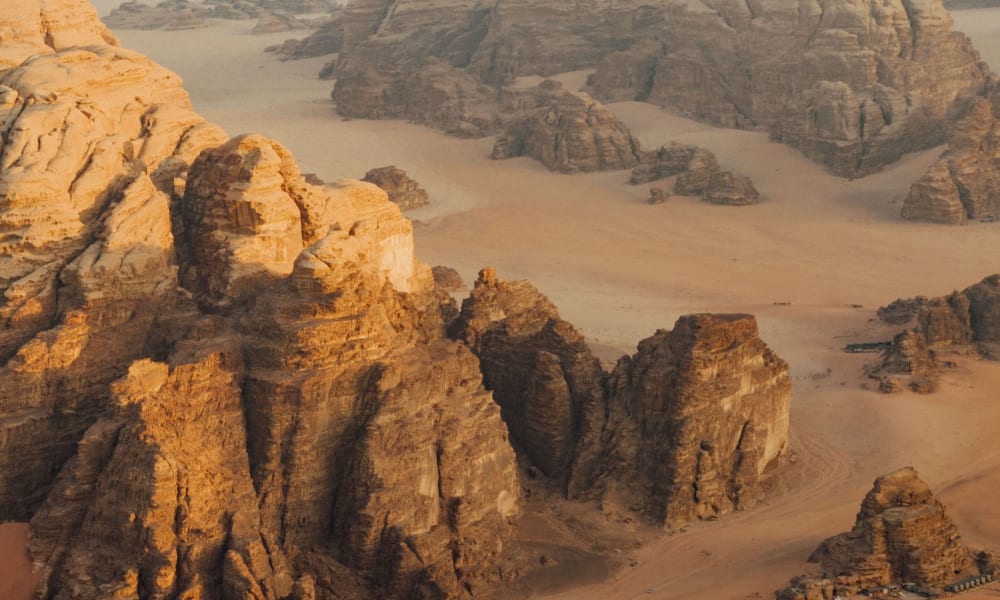
Saudi Arabia
Tourism between Desert, World Heritage & Red Sea
The desert state of Saudi Arabia borders on the Red Sea and the Persian Gulf. It is not without reason that the Arabian peninsula is considered an up-and-coming holiday destination: the kingdom delights travellers with exciting contrasts. Between majestic dunes, wide horizons in bright orange-red, wild mountain landscapes and ultra-modern metropolises, there is no limit to the spirit of adventure.
- FAQ: Frequently Asked Questions about Saudi Arabia
- 10 Quick Facts about Saudi Arabia
- Popular destinations Saudi Arabia
- Important rules of conduct for tourists in Saudi Arabia
- Infrastructure & Transportation
- Saudi Arabia as a woman
- Culinary paradise: Food in Saudi Arabia
- Geography of Saudi Arabia: The most important in a nutshell
- Flora & Fauna
- Weather & Climate

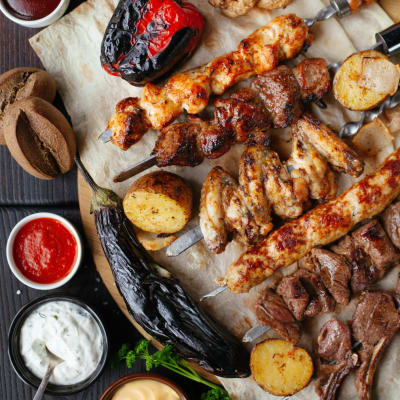
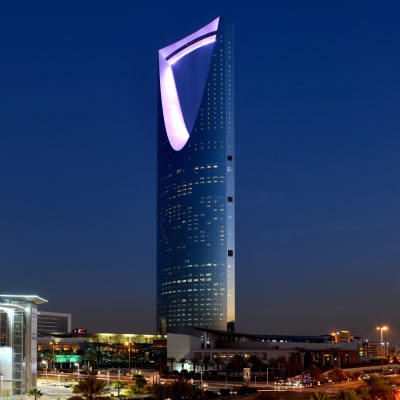
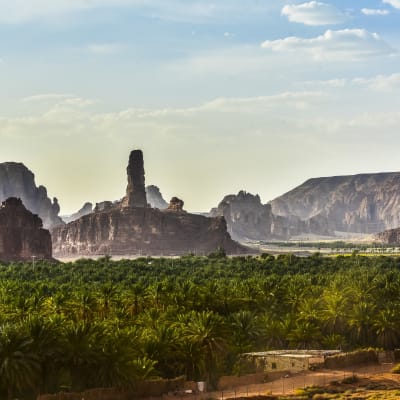
FAQ: Frequently Asked Questions about Saudi Arabia
Where to go on vacation in Saudi Arabia?
Since Saudi Arabia has opened its doors to tourists, the entire country can be visited - only the city of Mecca is reserved for people of the Muslim faith. In addition, the German Foreign Office advises against travelling to the regions along the border with Yemen due to ongoing political conflicts. Particular highlights are the cities of Riyadh, and Jeddah, located on the Red Sea and Dammam, on the coast of the Persian Gulf.
When is the best time to travel?
The best time to travel to Saudi Arabia is winter: From October to April, temperatures are comparatively mild (25 to 30 degrees Celsius). You are on the safe side, especially from November to March. In the summer months, it gets uncomfortably hot and dry - often up to 50 degrees Celsius.
Is it dangerous to travel to Saudi Arabia?
Saudi Arabia is now considered a safe travel destination with a well-developed tourist infrastructure. However, the German Foreign Office advises against travelling to the border areas with Yemen. These include the provinces of Najran and Jazan. The district of Qatif in the eastern province should also be avoided if possible.
What is prohibited in Saudi Arabia?
Those who inform themselves well in advance and behave according to the rules can get to know Saudi Arabia as a traditional but hospitable country that is happy to welcome tourists. The rules for travellers in Saudi Arabia are less strict than for the locals. Nevertheless, there are some rules to follow:
Dress code: Long sleeves; women should avoid too revealing and tied clothing.
Consumption of alcohol and pork is prohibited in public.
Photography and filming of people or public buildings are not allowed everywhere.
Decency rule: No exchange of affection in public.
The city of Mecca is reserved for people of the Muslim faith alone.
Can a woman travel alone to Saudi Arabia?
Yes, women can travel to Saudi Arabia alone. They do not need any permission or declaration and can apply for a visa - just like men. Nevertheless, it is (still) advised to travel to Saudi Arabia in male company. It is true that the peninsula is basically considered a safe travel destination with a very low crime rate. However, women still have fewer rights than men, which can lead to problems in the event of a legal dispute.
How do I apply for a visa to Saudi Arabia?
Since 2022, travelers from the Schengen area no longer have to apply for a visa in advance. Instead, they will receive a "visa on arrival", i.e. when they enter the country. The prerequisite is a passport that is still valid for at least six months. A visa fee of SAR 300 (€80) must also be paid by credit or debit card. The visa allows travelers to stay in the country for 90 days, multiple entries are possible.
How expensive is Saudi Arabia?
Restaurants, cab rides and hotel accommodations are up to 30 to 40% cheaper in Saudi Arabia compared to Germany. Leisure activities, on the other hand, are more expensive in Saudi Arabia. In general, prices are higher in big cities like Jeddah or Riyadh than in rural regions.
What is the tipping culture in Saudi Arabia?
In Saudi Arabia, it is common to tip. About 10-15% of the bill amount is appropriate.
In which time zone is Saudi Arabia located?
The time zone in Saudi Arabia is CET+2, so it is always two hours ahead of the Central European time zone. However, there is no summer and winter time in Saudi Arabia. If the clock is set to daylight saving time here (end of March to end of October), the time difference is only one hour.
10 Quick Facts about Saudi Arabia
1#
With 2,149,690 square kilometres, Saudi Arabia closely lost out, making it into the top 10 list of the world's largest countries, ranking 12th. Of Saudi Arabia's 35 million inhabitants, around 85% live in large cities. Four cities in Saudi Arabia are metropolises with millions of inhabitants.
2#
Saudi Arabia is an absolute monarchy, ruled since 2015 by Salman ibn Abd al-Aziz as king and president in one person. Islam is the official state religion.
3#
Riyadh is the capital of Saudi Arabia and translates to "gardens". There are over 4,000 mosques in the city.
4#
About 60 per cent of Saudi Arabia is covered by desert. In the south of the country is the Rub al-Kahli, the largest contiguous sand desert in the world.
5#
Saudi Arabia is home to six fascinating UNESCO World Heritage Sites. One of them is Hegra, the largest preserved Nabataean city south of Petra in Jordan.
6#
Saudi Arabia is located on the Red Sea. Due to its high salinity and volcanic activity on the seabed, it is the warmest sea in the world.
7#
Saudi Arabia is considered the "cradle of Islam," whose holiest city and destination for pilgrimage - Mecca - is also located in the country. However, Mecca is only accessible to people of the Muslim faith.
8#
Saudi Arabia is one of the driest and hottest countries in the world. In summer, temperatures can climb well above 45°C, while in winter they are usually a pleasant 25 to 35 °C. The average annual temperature is 30.7 °C.
9#
At first glance, the desert state seems rather barren - yet there are 200 species of aloe vera in Saudi Arabia alone! The fauna also surprises with animals such as the sand cat, the Arabian oryx and countless species of lizards, snakes and turtles.
10#
Saudi Arabian cuisine is traditionally rich in spices. Dates with coffee are popular for breakfast and as a snack during the day - alcohol and pork are forbidden due to the state religion Islam.
Popular destinations Saudi Arabia
From the national capital Riyadh in central Saudi Arabia, via the ancient Oasien settlement of Al'Ula in the north, your route could take you to the Red Sea and Jeddah. How about a stopover in Medina on the way there? As a crowning finale, the popular vacation resort of Taif offers itself... Your personal Saudi Arabia trip can look like this or something similar. We show you the most popular cities in the country here:
Riyadh - the capital
Riyadh, the capital of Saudi Arabia, is a place of discovery. Curious travellers can embark on a historical and cultural quest—experience places steeped in history, such as the ruins of Diriyyia and the famous Salwa Palace. A visit to the traditional Arab souks is a must. The colourful stalls are the heart of the city, a friendly meeting place. In contrast, the wide highways leading past gigantic skyscrapers seem almost like another world. Art lovers also get their money's worth in Riyadh: the modern metropolis is known for its growing art scene and noble galleries. An impressive panoramic view of the city is offered by the Kingdom Center, which rises more than 300 meters into the air.
King Abdullah Park invites you to linger. After an eventful day, you can look forward to Saudi Arabia's culinary highlights - whether you choose authentic street food or settle down in one of the countless chic restaurants.

Jeddah
Jeddah has become a popular tourist destination for a reason. The port city is located on the Red Sea and is considered an important cultural and economic centre of Saudi Arabia. The history of the commercial city goes back 2,500 years - and you can feel it: a popular sight is the "Gateway to Mecca," through which pilgrims once made their journey to the religious centre. Although Jeddah is a metropolis with a population of four million, the small alleyways and historic merchants' houses with wooden facades exude a unique charm. It's almost as if you've travelled back in time. This makes gigantic construction projects such as the Jeddah Tower all the more contrasting. At over 1,000 meters high, it is set to become the tallest building in the world.

Al'Ula
The ancient oasis city on the former Incense Road in northwestern Saudi Arabia is worth seeing in every way. Explore Al'Ula from camelback or lace up your hiking boots to climb rugged mountains and sandstone cliffs. See natural wonders such as the majestic elephant rock of Al-Fil, and the one-of-a-kind "dancing rocks" that grow from sand blown by the wind. Visit the oasis valley of Al'Ula - a lush green paradise that exudes beguiling scents of lemon and fig trees. An absolute highlight of Al'Ula is the old town: colourful markets, mosques and historic buildings, as well as craft pavilions that provide insight into millennia-old arts. Finally, after a long day in the oasis city, a cool drink awaits in an open-air bar in front of enchanting scenery.

Dammam
The former fishing village on the Persian Gulf is developing into an international tourist centre. The Dammam Corniche, an extended promenade around the bay, is particularly popular for strolling at sunset. Saudi Arabia's sixth-largest city delights travellers with its ultra-modern infrastructure, well-tended parks and a gigantic cultural offering. It is not without reason that Dammam is the adopted home of many ex-pats. The port city is considered the fastest-growing city in the Arab world! And if you've had enough of the big-city hustle and bustle, a trip to the nearby coral island of Murjan will ensure you can relax.

Ta'if
The "City of Roses" is located in a spectacular and comparatively cool mountain landscape east of Mecca. That's why Taif is easy to stay in during the summer, which has earned it the name "summer capital" of Saudi Arabia. In addition to roses, Taif is known for growing figs, honey, grapes and pomegranates. In short, a vacation day in the aesthetic city is accompanied by pleasant fragrances. The best view over the city is offered by Jabal Daka, the highest peak of Taif. The winding ride alone becomes an adventure! The Taif cable car Telefric Al Hada is also worthwhile, provided you are free from giddiness. Of course, Taif also has a lot to offer culturally. The Qantara Mosque, for example, is famous for its ancient architecture, while the Shubra Palace - now a museum - promises fascinating insights into the city's history.

Medina
Particularly significant for Medina, the fourth largest city in Saudi Arabia, is the mosque Masjid An Nabawi, built by the Prophet Mohammed. This mosque is also the Prophet's resting place; he is buried here. People from all over the world make pilgrimages to Medina to have once been to this special place. Islam's second holiest city was closed to tourists for a long time, but unlike Mecca, it has been accessible for several years. The Prophet's Mosque may only be entered by people of the Muslim faith, but the view of the white marble and the green dome is worthwhile from the outside alone and accessible for all visitors.

Abha
The cultural capital of Asir province is located in the green mountainous landscape of Saudi Arabia. Some of the highest peaks in the country are located here. The pleasant climate makes Abha a popular tourist destination. The region is best known for traditional markets, art and culinary delights. Those interested in culture will also get their money's worth: be sure to visit the Shadda Palace. The former government building is now a museum that takes you on a journey through Abha's past. The city is also known for its numerous historical mosques, which make you feel steeped in history. Your photo album will also benefit from a visit to Abha: The "fog city" looks as if clouds embed it due to its high location, which gives it a mystical atmosphere. The country's highest mountain, Jabal Sawda, is also located in the immediate vicinity. Travellers can take a cable car up to the top and enjoy the spectacular view.

Human Rights in Saudi Arabia: Ethical Reservations
For a long time, a trip to Saudi Arabia was considered a no-go because tourists feared that they would support the restrictive regime. Vision 2030, for example, is repeatedly described as greenwashing. On the other hand, a lot has changed in recent years. The opening to travellers has already significantly improved the situation of women in the country in particular. The accusation that the initiative and supposed openness to the world is purely economically motivated cannot be completely dismissed. At the same time, however, the opening of the country also holds the opportunity for understanding, cultural exchange and dialogue.
Important rules of conduct for tourists in Saudi Arabia
One issue that still prevents many people from travelling to Saudi Arabia is the legal situation in the country. This is because the Sharia applies in Saudi Arabia instead of a constitution, as we know it from European countries. This is legislation based on the Koran. In Saudi Arabia, fundamental human rights such as freedom of religion, freedom of speech and freedom of the press, the rights of women and minorities, and the death penalty are subordinated to this law. Since Saudi Arabia opened its doors to tourists, there has been a rapid change: the desert state is on a modernisation course. What was forbidden just a few years ago is now permitted. However, even though the rules for travellers have been significantly relaxed, some rules should be observed.
Do's
- Dress appropriately: long-sleeved, neat, and not provocative or revealing
- Esteem and accept hospitality (such as an invitation for coffee)
- Women are allowed to swim & sunbathe only on private beaches
- Learn a few essential phrases in Arabic to strike up a conversation with locals
Dont's
- Selling and consuming alcohol in public
- Eating and drinking in public during fasting (Ramadan)
- Taking pictures of people (especially women)
- Taking pictures of government buildings without being asked (does not apply to all regions, inform beforehand)
- Exchanging affection in public (kissing, holding hands, hugging)
- Talking about politics and religion
- Disparaging comments about the royal family
- Blowing your nose loudly in public
- Please do not use your left hand for eating and greeting, as it is considered unclean in the Islamic world
Dress code in Saudi Arabia
The dress code in Saudi Arabia is also becoming increasingly relaxed for travellers. For example, it is no longer obligatory for foreign women to wear a veil or headscarf. Nevertheless, Saudi Arabia is a conservative country. Therefore, tourists should observe some rules - especially outside the hotel - and pack their suitcases accordingly:
Men
- Long pants, because shorts are not welcome
- Long-sleeved tops that reach above the elbows (e.g., shirts made of light fabric)
- Native clothing (white robes and white or red-and-white headscarves) are usually taboo for foreign men
Women
- No open dresses, skirts and shorts (possible are, for example, wide, long dresses with leggings)
- Long-sleeved tops that reach above the elbows (e.g. blouses)
- When entering a mosque, the head must be covered
- Many tourists feel more comfortable wearing a long robe (abaya), which local women wear. A plain, black abaya can be ordered on the Internet before the trip.
Generally speaking, what is appropriate to wear varies depending on the occasion. For leisure activities (such as sports, on the beach or hiking in nature), the rules are seen somewhat more loosely than, for example, for business meetings or fancy restaurant visits. Especially at places of worship, care should be taken to wear neat and long clothing - even in hot temperatures. To prevent sunstroke, however, it is a good idea to pack something to protect your head from the sun, like a cap or sun hat.
The public display of tattoos and piercings is considered disrespectful in Saudi Arabia and is not welcome. When entering the country, tourists should consider removing piercings and cover-up tattoos.
Communication
The official language in Saudi Arabia is Arabic. However, especially in larger cities, many locals also speak English - especially the younger generation. Nevertheless, it is always appreciated if travellers make an effort and learn some vocabulary in Arabic. Tip: A small hand dictionary does not take up much space in your suitcase and is the ideal companion to please locals, make contacts and leave a good impression.
Hello
marhaba
Goodbye
mai alslama
Thank you
afwan
Yes
na'am
No
La
Sorry
alma trah
Infrastructure & Transportation
Saudi Arabia is about six times the size of Germany. So the distances from one travel destination to the next can be huge. That's why it's essential to know the best way to get from A to B on the Arabian Peninsula:
- Domestic flights: air travel is the fastest and most comfortable way to travel within the country. Cheap flights are available - depending on the route - from as little as 30 euros.
- Bus & Train: There are several rail routes in Saudi Arabia. The trains are highly modern and air-conditioned, connecting different metropolises. For example, there is a North Train and an East Train, which you can book via the SAR website (Saudi Railway Company). You can also reach more remote areas by bus. These can be booked online at SAPTCO - assuming you know Arabic.
- Taxi & Uber: There is hardly any public transport in Saudi Arabian cities - cabs are, therefore, the most important means of transportation. As a general rule, the fare should always be negotiated in advance. If you prefer to avoid this, you can also use the Uber app or the local app Careem.
- Rental cars: You need an international and German driver's license to rent a car. There is right-hand traffic in Saudi Arabia. You will only find gas stations on major roads. Since 2018, women are also allowed to drive in the country.
Important: The infrastructure in Saudi Arabia is not as well developed as you might know it from Europe. Within the cities, there are often traffic jams and traffic chaos. The rural areas are often only equipped with poor roads. If you book an organised round trip with us, you are, in any case, on the safe side.
Good to know: Tips for your Saudi Arabia trip.
Saudi Arabia is a fascinating country that probably has a lot of unknowns in store for you. So that you are well prepared for your trip to the mysterious desert state, we have put together a few more tips for you:
- Best time to travel: the desert climate in Saudi Arabia leads to significant temperature differences between the seasons. Even within the country, the climate can vary significantly along the north-south axis or between the coast, desert and mountains. A recommended time to travel is during the mild months between October or November through February and March. It would be best if you also planned at least a week or two for a round trip.
- Currency: In Saudi Arabia, you pay with Saudi Riyal (SAR), where one Euro is equivalent to about four SAR. The easiest way to pay locally is with an international credit card. However, you can also withdraw cash from local ATMs.
- Food & Drink: Traditional Saudi Arabian cuisine is based on oriental spices such as cloves, pepper and coriander. Typical dishes include lamb kebabs, couscous or tabouleh. Pork is strictly forbidden in the Islamic country - this also applies to alcohol, although many hotels make exceptions for tourists.
- Language: The official language in Saudi Arabia is Arabic. However, vacationers will have no problems communicating in English. Traffic signs are also usually labelled in both Arabic and English.
- Islamic or Gregorian calendar: Different calendars are used in Saudi Arabia, depending on the context. As a tourist, you will mainly come into contact with the Gregorian or Western calendar. However, in a religious or local context, the Islamic calendar is also used, which is based on the moon and determines, for example, the timing of the fasting month of Ramadan.
Hospitality in Saudi Arabia
Hospitality is very important in Saudi Arabia. As in many Islamic communities, guests are seen as a gift from God. Taking care of guests is an opportunity to do good and gain favour in the eyes of Allah. So when travelling in Saudi Arabia, don't be surprised if you receive gifts, are invited to dinner, or are shown around for a whole day. Such attention may be gladly accepted and are not a "fraudulent scam", although, of course, there may be exceptions. It should be noted that some Saudi locals will pay special attention to you the whiter you are.
Important: Do not feel pressured by potential gifts to give something back. Sometimes this can even be taken as insulting.
Saudi Arabia as a woman
The wide gap between men and women and the lack of rights for the female sex often cause reservations about visiting the Muslim country. The status of women in Saudi Arabia is so complex that a book could be written about it. Genders are strictly separated in Saudi Arabia - even within families, and not only spatially: The division of tasks is also based on gender. The fact is that women in Saudi Arabia are still granted fewer rights than men. In recent years, however, there have been many welcome changes in the country. For example, they are now allowed to drive a car, participate officially in elections, file for divorce, leave the country on their own, and much more. For some time now, on average, just as many women as men have been enrolling in universities. We see: Saudi Arabia is opening up and is well on the way to ensuring that women are no longer regarded merely as "men's accessories.
Can I go to Saudi Arabia alone as a woman?
In principle, it is possible to travel alone to Saudi Arabia as a woman. However, female solo travellers should be prepared for the fact that they may be treated differently than male travellers. Rules that apply to Saudi women play a subordinate role to foreign women. However, the strict separation of the genders is also present for tourists; for example, when eating out: Especially in smaller towns and the countryside, men and women have to dine at separate tables or even in different restaurant rooms. However, more and more restaurants, especially in the metropolises and tourist areas, are increasingly relaxing this rule. Even in hotels and resorts, gender segregation at meals is not common.
Clothing: What women should consider
Saudi women are usually fully veiled: They wear a black robe that reaches to the floor (abaya) and a black headscarf (hijab), and sometimes also a niqab that covers the face except for the eyes. Foreign women are not expected to follow this dress code. However, many female tourists are unsure of what clothing is appropriate. No wonder: the gap between official rules and cultural customs could hardly be wider. According to official regulations, foreign women in Saudi Arabia can wear whatever they want. The only requirements are
- long sleeves,
- fully covered legs and
- no excessive cleavage.
It does not matter what colour the clothing is. Wearing a headscarf is not mandatory for travelling women. Nevertheless, many tourists decide to wear an abaya just like Saudi women and cover their heads - at least with a loose veil.
Safety tips
Sexual harassment is severely punished in Saudi Arabia. Therefore, female travellers are generally at little risk of suffering severe assaults. Saudi men are usually less intrusive than many women experience in other countries. Nevertheless, it is important to be mindful and observe the following safety measures:
- Do not give out your private cell phone number or other data (e.g., social network contact information). In Saudi Arabia, Snapchat is especially common.
- If a man harasses you, take a picture of him or his car's license plate (or pretend to). It is possible to report men for harassment if you have evidence, which will deter many men.
- Be wary of particularly talkative men and avoid eye contact unless you are interacting.
- Do not touch local men unless you know them. This also applies to shaking hands unless the man offers his hand first.
- Do not sit next to a local man (such as in public areas) unless you are related or otherwise known.
Culinary paradise: Food in Saudi Arabia
To travel into Saudi Arabia's past, not only historical sites and museums are suitable, but also typical restaurants or street food stands: The cuisine of the desert state is considered one of the most traditional in the world. Recipes have been passed down from generation to generation and have hardly changed. The food is often eaten in large groups: huge plates are placed in the middle, and everyone takes a bite. Traditional Saudi cuisine is based on regional products and oriental spices such as cloves, pepper, saffron, allspice, cardamom and coriander. In short: Look forward to a taste explosion!
Did you know?
Saudi food is often spicy. Just let them know: "Please not so spicy." means "Bidoune tawabil!" in Arabic.
Saudi cuisine is known for being meat-heavy. Lamb and chicken, in particular, are often on the menu (for example, in the form of skewers or kebabs), beef is less common. Pork is forbidden in the Muslim country. Fish and seafood are also popular on the coast. However, those who eat a vegetarian diet do not need to worry. Most restaurants now also offer many plant-based dishes.
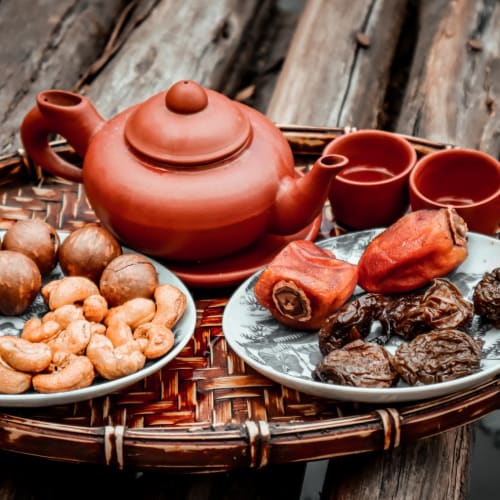
Breakfast typical of the country
For many Saudis, breakfast is rather small and consists of dates ("bread of the desert") or figs and "gahwa," for example. This is the name given to the typical Arabic coffee, which is known for its spicy aroma.
By the way, coffee is considered a symbol of hospitality in Saudi Arabia and is always offered everywhere. Those who do not drink coffee can look forward to black-sweetened tea with fresh mint and lemon.
Those who like it a bit more sumptuous in the morning will reach for fatteh or pitta. These are Arabic breads that are freshly fried or deep-fried and cut into bite-sized pieces. Manaqish - delicious dough patties - are also popular in the morning. The filling pieces of bread are great dipped in hummus or fresh yoghurt with mint.

Lunch typical of the country
As in many countries, lunch is the main meal in Saudi Arabia. An important ingredient that is not missing from any meal is rice. Bulgur, lentils, chickpeas, and couscous are also typically filling side dishes of the country's cuisine.
One of the Saudi national dishes is Kabsa: the heavenly combination of rice, meat, vegetables, and numerous spices is a must-try!
Appetisers and side dishes include olives, falafel - fresh balls of chickpeas - salads such as tabbouleh and pitta bread with dips such as hummus or tahini.
Important: Always dip bread with your right hand, as the left hand is considered unclean in Saudi Arabia.
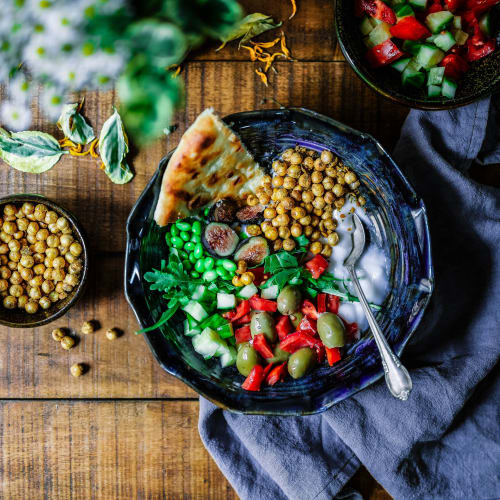
Dinner typical of the country
The last meal of the day in Saudi Arabia usually occurs late when the heat has subsided a bit.
Typically, the evening meal tends to be light, such as soup or steamed vegetables. Stuffed zucchini and eggplant are popular. Fried eggs or rice balls are also typical snacks in Saudi Arabia, as is "tattoush," a delicious bread salad.
Geography of Saudi Arabia: The most important in a nutshell
Saudi Arabia is located on the Arabian Peninsula and borders with
- Jordan,
- Iraq,
- Kuwait,
- Qatar,
- Oman,
- Yemen,
- and the United Arab Emirates.
Administratively, the country is divided into 13 provinces (also called emirates), which are again divided into many small administrative districts.
In the west, the desert state borders on the Red Sea, in the east on the Persian Gulf. In the south lies the Asir Mountains, which extend up to 3,000 meters in altitude. Here are also the highest mountains in the country: Jabal Ferwa and Jabal Sauda. Due to the high altitude, the climate is much milder, and the precipitation is higher, making Asir province one of the greenest regions in Saudi Arabia. Therefore, especially in summer, Asir serves as a popular refuge for locals.
There are no rivers or lakes in Saudi Arabia, only a few dried-up river beds (wadis) that occasionally carry water after heavy rainfall. The country consists mainly of vast desert landscapes and volcanic rocks.
Islands off Saudi Arabia
Off the coast of Saudi Arabia in the Red Sea is the Farasan chain of islands, which includes about 80 islands. Most of them are very small and only sparsely populated. The largest of the islands is called Farasan al Kabir, with an area of just under 400 km² and a population of 18,000. Coral reefs surround the tropical island with a beautiful white sandy beach, which attracts tourists repeatedly. Farasan al Kabir can be easily reached by ferry.
Red Sea Project: Green Paradise in the Red Sea
To further boost tourism and create new jobs, the kingdom is planning a massive project on the west coast: By 2030, a new tourism centre is to be built that will extend over 22 islands and, in addition to luxury resorts, a yacht harbour and wellness centres, will also be equipped with an airport. What makes the project special is its sustainability aspect. The entire centre is to be built in an environmentally friendly manner and be close to nature despite the highest levels of luxury. According to the plan, the airport will run on 100 per cent renewable energy. Marine studies are tasked to provide information on how damage to the coral reef can be avoided.
The Red Sea
The Red Sea
The Red Sea is a strait between the northeast of Africa and the Arabian Peninsula. For the Kingdom, the Red Sea is of immense importance: the water is warm (20 - 26 degrees Celsius), has a high salt content and is protected from external water influences. These conditions have turned the Red Sea off Saudi Arabia's shores into a fascinating underwater world. It is teeming with a wide variety of fish species, plants and other marine life—no wonder the reefs have become a paradise for diving and marine enthusiasts.
The Persian Gulf
The Persian Gulf is significantly smaller than the Red Sea. It separates Saudi Arabia from Iran and Iraq and flows into the Gulf of Oman, which flows into the Arabian Sea. The salinity is similar to that of the Red Sea. Here, too, a multifaceted underwater world can be marvelled at! The swell is low, which makes the Persian Gulf a great swimming hotspot.
Important
Women are usually not allowed to wear bikinis on public beaches. In the hotel resorts and associated private beach sections, however, this is possible without further ado.
Flora & Fauna
Due to the dry desert heat, one looks in vain for lush green landscapes in Saudi Arabia - at first glance. If you look a little closer, you can discover numerous exotic plant species. Among them are for example Aloe vera, the oldest medicinal plant in the world, fig trees, whose delicious fruits are offered on every corner, and the miracle flower, which can produce up to five different colored blossoms. In total, more than 600 species of fruit trees and shrubs grow in Saudi Arabia. Above all, date palms: Saudi farmers harvest more than one million tons of dates annually!
Did you know?
To help protect the environment, Saudi Arabia has set a goal of planting 450 million trees throughout the country. These and other initiatives are expected to filter around 200 million tons of carbon emissions from the atmosphere.
Camels in Saudi Arabia
When you think of a desert country like Saudi Arabia, the first thing that comes to mind when you think of the animal kingdom is the camel. The sand-coloured oaf is undoubtedly the country's national animal. Camels have been domesticated for thousands of years and used for a wide variety of purposes: they form the hub of every caravan, being heavily loaded with goods but also with people. Camel wool is woven into cloth; camel milk is milked and drunk or used to produce other products like chocolate or soap. The milk of the animals is considered particularly healthy because it is rich in antioxidants. In terms of taste, it is similar to cow's milk but a little saltier and spicier. When a camel dies, its meat is eaten, and the skin is made into leather.
Camel races and beauty contests are also famous. The latter, in particular, have come under heavy criticism following a scandal involving Botox and doping in isolated cases.
If you travel within Saudi Arabia's cities, you will not see any camels, but you will see them on all country roads and smaller highways - and in the rural regions and desert areas anyway.
What other animals are there in Saudi Arabia?
Besides camels, you can also look out for baboons: Baboon gangs regularly rampage along the roadside in search of food.
But be warned: the burly monkeys can get cheeky and are master thieves. If you get out of your car for a photo, be sure to lock it before one of the baboons steals your provisions.
Other species native to Saudi Arabia include insects, such as a wide variety of colourful butterflies. You may also see various species of snakes, scorpions and lizards. Even the oryx antelope, which was on the verge of extinction, has been reintroduced to the desert state and is now protected.
The most extraordinary biodiversity in Saudi Arabia is probably found in the Red Sea: from countless exotic fish species, jellyfish and octopuses to sea turtles, sharks, whales and dolphins - not to mention the dazzling coral reefs!
Weather & Climate
If you like it warm, the Saudi desert state is just right. Because Saudi Arabia is a very dry and hot country - ideal to escape the long and cold winter! Rain hardly ever falls. Only in the northern mountain regions can it drip now and then in the winter months.
Lows
...are measured in December or January with an average of 20 degrees. In the northern regions, however, temperatures can reach freezing points, especially at night. The Asir Mountains are comparatively cool.
Maximum values
...are the summer months from June to September, when temperatures reach 40 degrees and more almost continuously. Sometimes the thermometer even climbs to 50 degrees - not exactly ideal for travelling.
The best time to travel: October to April
The best time to travel are the winter months, from October to April. It gets so hot and dry in summer that sightseeing, swimming and all other activities are hardly bearable. It can be endured in winter with warm but still pleasant temperatures of 25 to 35 degrees. The good thing is that the humidity is not very high during this time either!
